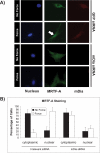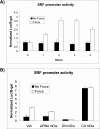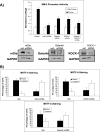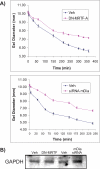Force-induced myofibroblast differentiation through collagen receptors is dependent on mammalian diaphanous (mDia)
- PMID: 20071339
- PMCID: PMC2838345
- DOI: 10.1074/jbc.M109.075218
Force-induced myofibroblast differentiation through collagen receptors is dependent on mammalian diaphanous (mDia)
Abstract
The development of fibrosis promotes the differentiation of myofibroblasts, pro-fibrotic cells, which contribute to tissue dysfunction. Myofibroblast differentiation is dependent on actin assembly, which in response to force, is mediated by various actin-binding proteins including the mammalian Diaphanous-related formins (mDia). We examined the role of mDia in the mechano-sensing pathway that leads to force-induced expression of alpha-smooth muscle actin (SMA), a marker and critical determinant of myofibroblast differentiation. In cells treated with siRNA to knockdown mDia and then subjected to tensile force using collagen-coated magnetite beads attached to beta1 integrins, actin assembly was inhibited at bead contact sites. Force-induced nuclear translocation of MRTF-A, a transcriptional co-activator of SMA, was reduced 50% by mDia knockdown. The expression of the transcriptional co-activator of SMA, serum response factor, was reduced by 50% after siRNA knockdown of mDia or by 100% in cells transfected with catalytically inactive mDia. Force-induced activation of the SMA promoter and SMA expression were blocked by knockdown of siRNA of mDia. In anchored collagen gel assays to measure myofibroblast-mediated contraction, knockdown of mDia reduced contraction by 50%. We conclude that mDia plays an important role in the development of force-induced transcriptional activation of SMA and myofibroblast differentiation.
Figures








Similar articles
-
Force activates smooth muscle alpha-actin promoter activity through the Rho signaling pathway.J Cell Sci. 2007 May 15;120(Pt 10):1801-9. doi: 10.1242/jcs.001586. Epub 2007 Apr 24. J Cell Sci. 2007. PMID: 17456553
-
FAK, PIP5KIgamma and gelsolin cooperatively mediate force-induced expression of alpha-smooth muscle actin.J Cell Sci. 2009 Aug 1;122(Pt 15):2769-81. doi: 10.1242/jcs.044008. Epub 2009 Jul 13. J Cell Sci. 2009. PMID: 19596799
-
Rho activation of mDia formins is modulated by an interaction with inverted formin 2 (INF2).Proc Natl Acad Sci U S A. 2011 Feb 15;108(7):2933-8. doi: 10.1073/pnas.1017010108. Epub 2011 Jan 28. Proc Natl Acad Sci U S A. 2011. PMID: 21278336 Free PMC article.
-
Cofilin is a marker of myofibroblast differentiation in cells from porcine aortic cardiac valves.Am J Physiol Heart Circ Physiol. 2008 Apr;294(4):H1767-78. doi: 10.1152/ajpheart.01305.2007. Epub 2008 Feb 8. Am J Physiol Heart Circ Physiol. 2008. PMID: 18263709
-
Mechanical force regulation of myofibroblast differentiation in cardiac fibroblasts.Am J Physiol Heart Circ Physiol. 2003 Nov;285(5):H1871-81. doi: 10.1152/ajpheart.00387.2003. Epub 2003 Jul 3. Am J Physiol Heart Circ Physiol. 2003. PMID: 12842814
Cited by
-
The actin-MRTF-SRF gene regulatory axis and myofibroblast differentiation.J Cardiovasc Transl Res. 2012 Dec;5(6):794-804. doi: 10.1007/s12265-012-9397-0. Epub 2012 Aug 17. J Cardiovasc Transl Res. 2012. PMID: 22898751 Review.
-
Myocardin-related transcription factor-A complexes activate type I collagen expression in lung fibroblasts.J Biol Chem. 2011 Dec 23;286(51):44116-44125. doi: 10.1074/jbc.M111.276931. Epub 2011 Nov 2. J Biol Chem. 2011. PMID: 22049076 Free PMC article.
-
Myofibroblast differentiation and survival in fibrotic disease.Expert Rev Mol Med. 2011 Aug 23;13:e27. doi: 10.1017/S1462399411001967. Expert Rev Mol Med. 2011. PMID: 21861939 Free PMC article. Review.
-
Hic-5 is required for myofibroblast differentiation by regulating mechanically dependent MRTF-A nuclear accumulation.J Cell Sci. 2016 Feb 15;129(4):774-87. doi: 10.1242/jcs.170589. Epub 2016 Jan 12. J Cell Sci. 2016. PMID: 26759173 Free PMC article.
-
Signaling mechanisms that regulate smooth muscle cell differentiation.Arterioscler Thromb Vasc Biol. 2011 Jul;31(7):1495-505. doi: 10.1161/ATVBAHA.110.221135. Arterioscler Thromb Vasc Biol. 2011. PMID: 21677292 Free PMC article. Review.
References
Publication types
MeSH terms
Substances
Grants and funding
LinkOut - more resources
Full Text Sources

